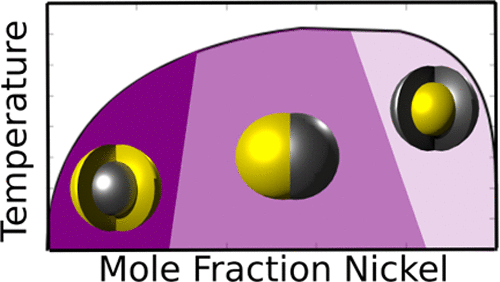当前位置:
X-MOL 学术
›
J. Phys. Chem. C
›
论文详情
Our official English website, www.x-mol.net, welcomes your
feedback! (Note: you will need to create a separate account there.)
Thermodynamic Determination of Bimetallic Particle Geometry: Suitability of Poorly Miscible Alloys for Surface-Enhanced Raman
The Journal of Physical Chemistry C ( IF 3.3 ) Pub Date : 2020-01-23 , DOI: 10.1021/acs.jpcc.9b10889 Chelsea M. Mueller 1 , Raghavendra R. Murthy 1 , Marc R. Bourgeois 1 , George C. Schatz 1
The Journal of Physical Chemistry C ( IF 3.3 ) Pub Date : 2020-01-23 , DOI: 10.1021/acs.jpcc.9b10889 Chelsea M. Mueller 1 , Raghavendra R. Murthy 1 , Marc R. Bourgeois 1 , George C. Schatz 1
Affiliation

|
Bimetallic nanoparticles formed of poorly miscible alloys are attractive for applications in surface-enhanced Raman scattering (SERS), as they could allow the detection and study of analytes that do not bind well to typical plasmonic substrates, particularly important biomolecules such as serotonin. Despite their potential importance for SERS applications, the plasmonic and geometric properties of these alloys are not well characterized. Here, we present a method for calculating the thermodynamically minimized geometries of these nanoparticles as a function of their surface, bulk, and metallic phase interface energies. We show how the geometry varies as a function of composition, from core–shell, to Janus, to phase-separated, and discuss the importance of accurately modeling the metallic phase interface region to capture particle geometries. Finally, we use the calculated Janus geometries for the AuNi and AgNi systems to explore the suitability of these particles for use in SERS and identify the ideal compositions to maximize local field enhancement on the Ni-rich phase of the particle using the finite-difference time-domain method.
中文翻译:

双金属颗粒几何形状的热力学测定:差混溶合金对表面增强拉曼的适用性
由互溶性差的合金形成的双金属纳米粒子在表面增强拉曼散射(SERS)中的应用很有吸引力,因为它们可以检测和研究与典型等离激元底物(特别是重要的生物分子,例如5-羟色胺)结合不好的分析物。尽管它们对SERS应用具有潜在的重要性,但这些合金的等离激元和几何性质仍无法很好地表征。在这里,我们提出了一种计算这些纳米颗粒的热力学最小几何形状的方法,这些几何形状是它们的表面,体积和金属相界面能的函数。我们展示了几何形状如何随成分的变化而变化,从核-壳,Janus到相分离,并讨论了精确建模金属相界面区域以捕获粒子几何形状的重要性。
更新日期:2020-01-24
中文翻译:

双金属颗粒几何形状的热力学测定:差混溶合金对表面增强拉曼的适用性
由互溶性差的合金形成的双金属纳米粒子在表面增强拉曼散射(SERS)中的应用很有吸引力,因为它们可以检测和研究与典型等离激元底物(特别是重要的生物分子,例如5-羟色胺)结合不好的分析物。尽管它们对SERS应用具有潜在的重要性,但这些合金的等离激元和几何性质仍无法很好地表征。在这里,我们提出了一种计算这些纳米颗粒的热力学最小几何形状的方法,这些几何形状是它们的表面,体积和金属相界面能的函数。我们展示了几何形状如何随成分的变化而变化,从核-壳,Janus到相分离,并讨论了精确建模金属相界面区域以捕获粒子几何形状的重要性。











































 京公网安备 11010802027423号
京公网安备 11010802027423号